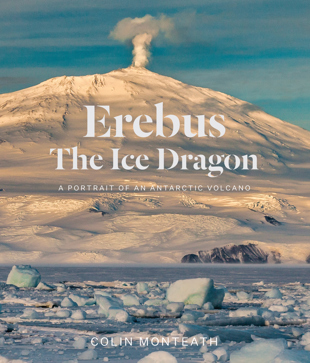David Barnes has reviewed Colin Monteath’s Erebus The Ice Dragon: A portrait of an Antarctic volcano in the Otago Daily Times:
‘Mt Erebus (at 3794m, 70m higher than Aoraki Mt Cook) dominates Ross Island, the site of New Zealand’s Scott Base, the American McMurdo Station and the historic huts that stand as monuments to the early 20th century exploits of Shackleton and Scott. Anyone who has visited or worked there will frequently find their eyes drawn to the skyline and the almost constant plume of steam.
It would be difficult to think of anyone better qualified than Colin Monteath to write the story of Antarctica’s best-known volcano. His CV includes 32 summer seasons on ice — initially supporting science programmes and later in tourism and photography — three ascents of the mountain and the bold first descent into its inner crater, as well as a key role in the aftermath of the 1979 Air New Zealand crash, the event that seared the name Erebus into the New Zealand psyche.
The opening chapter sets the scene by summarising the geological and human history of Antarctica. This is followed by a chapter on the many volcanoes, active and extinct, on the continent and the oceans that surround it. Then it’s on to the remarkable story of the 1841 discovery of the volcano, along with the Ross Sea and what is now called the Ross Ice Shelf. Captain James Clark Ross, a seasoned Arctic veteran, was seeking the South Magnetic Pole. He boldly took his two sailing ships, HMS Erebus and HMS Terror, into the pack ice, and was surprised to find open water to its south. The discovery of what ship’s surgeon Robert McCormick called “a stupendous volcanic mountain in a high state of activity” was an even greater surprise.
The mountain received its first ascent in 1908 by members of Sir Ernest Shackleton’s 190709 expedition, and its second four years later by members of Robert Falcon Scott’s final expedition. Each has its own well-described chapter. The mountain was then untouched until 1959, when the nearby scientific bases had been established, and from then much of the activity on it was as part of science programmes.
There was an obvious need to cover the 1979 tragedy and the decision to use first person accounts by four members of the recovery team, including Monteath himself, has worked well.
The book rounds out with the artistic imagination by Canterbury academic Adele Jackson. Paintings and literature are prominent, but the wide-ranging examination also extends to sculpture and musical composition. When so much Antarctic writing is focused on history, science and adventure, having a chapter like this adds to the richness of the work.
Despite the breadth of events and activities, Monteath keeps the narrative moving in a very readable way. This is the case even when delving deep into volcanology or the life of extremophiles. The selection of illustrations is outstanding, many by the author, but he has clearly made full use of his Antarctic contact list to source many contemporary photographs of science and polar life. There are also many archival photographs of early exploration, as well as paintings from all eras. This really was a great read, and will be an essential addition to polar libraries, large and small.’


